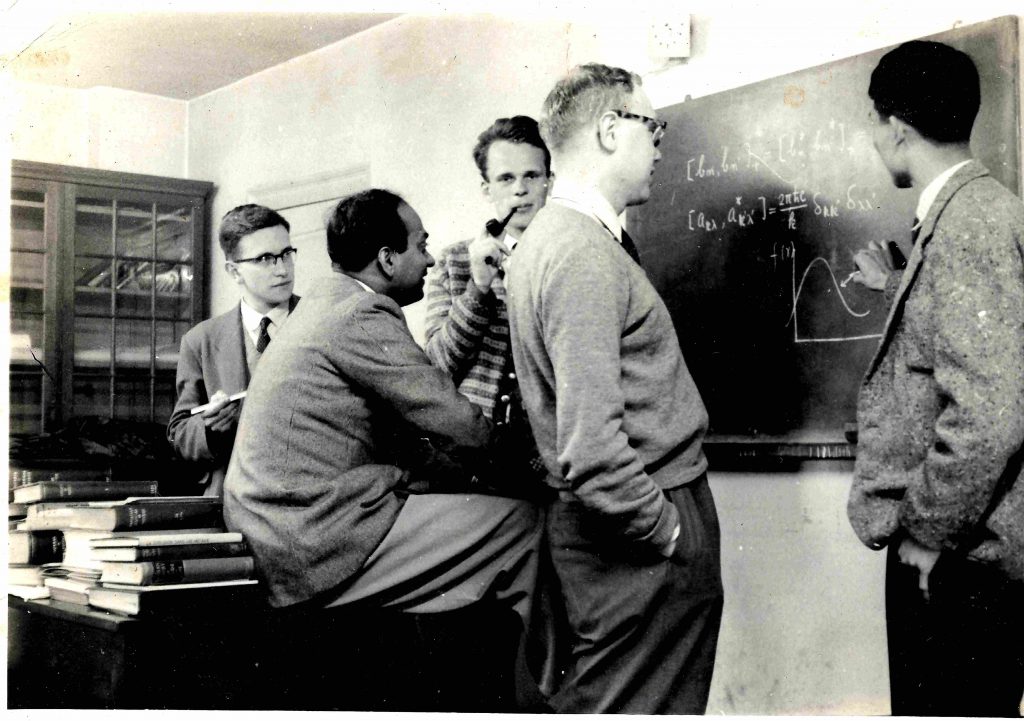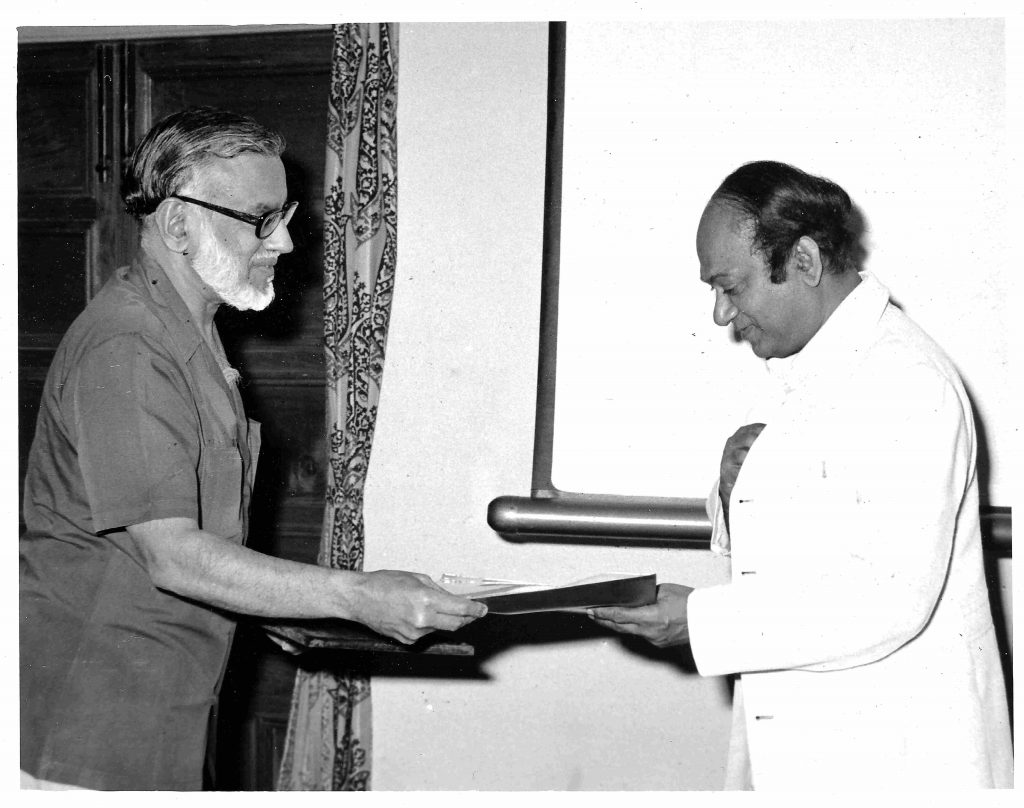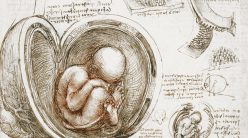KP Sinha, a versatile physicist whose association with IISc stretches back almost fifty years, will turn 90 in July 2019

KP Sinha is an unusual man. Getting one PhD is hard work, but he chose to do two. And rare though it is for theoretical physicists to work in more than one field, Sinha mastered several, taking to cosmology with as much ease as his forte of condensed matter physics.
“This was a unique fearlessness of Prof Sinha,” says G Baskaran, one of Sinha’s earliest students at IISc, and now an emeritus professor at the Institute of Mathematical Sciences, Chennai. “It was good for young people like me. We grew in that atmosphere, not scared by subdivisions.”
Sinha arrived at IISc in 1970 on the invitation of the then Director Satish Dhawan, as a full professor in the departments of Applied Mathematics and Physics. Dhawan had met Sinha in New York, where Sinha was a researcher at the legendary Bell Labs, Murray Hill.
But Sinha’s first tryst with IISc goes back further, to 1951, when a chance meeting changed the course of his career. After his MSc at the University of Allahabad in 1950, he taught at a college in his native town of Arrah, Bihar. On a trip to Bangalore to attend the Indian Science Congress in 1951, held at IISc, he happened to meet JW McBain, the first Director of the National Chemical Laboratory (NCL), Pune. “He invited me to come to Pune,” recalls Sinha. “So on the return trip, I went to Pune, and they offered me a job. I came back to Arrah, resigned from my teaching job, and went to Pune.”
Sinha arrived at IISc in 1970 on Satish Dhawan’s invitation
Soon, McBain arranged for Sinha to go to Stanford University (where McBain had been a professor of chemistry before coming to NCL). But a change at the helm of NCL forced a change of plan. McBain retired, and GI Finch, an Australian chemist from Imperial College, London, arrived as director of NCL. Finch was a man of varied interests, having studied physiology in Paris, and chemistry and physics in Zurich. (He was also a mountaineer who pioneered the use of bottled oxygen at altitude.) Sinha stayed at NCL and worked with Finch, an expert in electron diffraction, studying magnetic properties of iron oxides. This work earned him a PhD in experimental physics from Poona University (now Savitribai Phule Pune University), in 1956.
Sinha then moved to the University of Bristol to work with the British physicist MHL Pryce, whom he remembers as “a very difficult man”. Pryce was studying the magnetic properties of atoms, and the effect such properties had on the lattice of crystals. In some materials, such as perovskites, the electronic state of the transition metal ions distorts the material’s lattice. This is because the electrons try to rearrange themselves to reach the lowest energy state. When all electrons associated with the transition metal ions try to do this, there is a distortion of the lattice as a whole, a phenomenon known as the cooperative Jahn-Teller effect. Sinha worked with some of the leading lights in this area, such as Pryce and the Japanese physicist Yukito Tanabe.

His work during this stint at Bristol earned him a second PhD, this time in theoretical physics (awarded in 1965). He returned to NCL in 1959, as group leader of the Solid State and Molecular Physics unit.
It was during Sinha’s time at NCL that he met the young Narendra Kumar, who went on to become a distinguished physicist and Director of the Raman Research Institute. (He passed away in 2017.) Kumar was a Senior Scientific Officer at the Institute of Armament Technology in Pune when he wrote a paper in Nature. That got him noticed in NCL, where he was invited to work as a replacement for the nuclear magnetic resonance (NMR) spectrometer operator who was going abroad on study leave. “As it happened, the NMR operator was not granted a visa after Kumar moved to NCL as a Scientist B,” noted an obituary of Kumar in Current Science, “and Sinha nobly allowed the young engineer to work full-time on his passion – theoretical physics.” Kumar worked with Sinha, obtaining his PhD from IIT Bombay.
Their work in this period, which Sinha continued later with others, made headlines in 1994. “A theoretical physicist from India has been pushed into the centre-stage of world science,” announced a news report in Times of India on 4 June 1994, “after scientists around the world confirmed a prediction of great importance he had made 25 years ago.”
What they had theorised was a new kind of superconductivity. In most materials, electrons repel each other and collide with the lattice ions, experiencing resistance, and dissipating energy, as they travel. In a superconducting material, however (at the right temperature – usually much below room temperature – and pressure), the electrons “pair” together, and “flow” without resistance. This interaction between the paired electrons is mediated by phonons, which are the quantised form of the lattice vibrations. Sinha and Kumar took another boson, the photon, and asked if it too could mediate such a pairing between electrons.
“They were partly inspired by an experiment where you shine microwave radiation on a superconductor,” says Baskaran, “causing the superconducting property to become stronger.” This is because the microwave radiation causes the transition temperature, at which the material becomes superconducting, to increase. Sinha and Kumar wondered if photons could do the trick on their own in certain materials that are otherwise semiconductors, at a relatively high temperature. In their theory, the superconducting property would vary according to the intensity and wavelength of light, making the superconductor tunable.
This transient phenomenon, known as photo-induced superconductivity, was observed in 1994 in semiconducting films made of oxides of yttrium, barium and copper. But this discovery hasn’t turned out to be quite as revolutionary as the news report anticipated. “It’s an interesting observation, but whether the Sinha-Kumar mechanism is at work or not is a separate issue,” says Baskaran. “But they were far ahead of their time.”
Their work was published in a 1968 paper. The same year, Sinha left NCL for Bell Labs, a career move that, once again, was due to a chance event. He was attending a conference in the US, where, he admits, he “had the habit of asking too many questions.” Among the attendees was a senior researcher from Bell Labs. “He was impressed, and he met me and said ‘Why don’t you visit us at Bell Labs?’” Sinha took up the offer and was soon offered a position there.

When he came back to NCL, he approached the Council of Scientific and Industrial Research, CSIR (of which NCL is a part), requesting leave to join Bell Labs. “CSIR saw how much money I’d be getting at Bell Labs – they converted it into rupees – and they felt it was too much. They said, ‘We’ll give you leave, provided you give us a part of your salary at Bell Labs,’” says Sinha, laughing. “I declined and resigned my post and went to Bell Labs with my family.”
And it was while Sinha was at Bell Labs that Dhawan invited him to IISc. Kumar too arrived at the Institute in 1972. Around the same time, Baskaran, who had joined as a student in the Applied Mathematics department, shifted to the Physics department to work with Sinha and Kumar.
“Both KP and Kumar changed the scene in the department,” Baskaran wrote in a souvenir marking IISc’s centenary in 2009, “by making student-teacher relations very informal and cordial.” He credits Sinha and Kumar for starting work on theoretical condensed matter physics at IISc. “There were lots of beautiful experiments going on already at the department, but theory work was started by them,” he says. “In some sense it prepared ground to take the Physics department to newer heights when Prof TV Ramakrishnan [also a professor in the department] arrived later.”
“Both KP and Kumar changed the scene in the department”
At IISc, Sinha continued to work on the magnetic properties of solids, in particular, the interactions among excitations in magnetic systems. Just as ordinary solids carry sound waves, magnetic materials carry magnetic waves. In the quantum mechanical picture, the energy that such waves carry is in discrete form, called quanta – known as phonons for sound waves, and magnons for magnetic waves. Sinha, with several of his students, extensively studied how magnons interact with phonons and electrons. In fact, he studied all possible such interactions in magnetic solids – among magnons, phonons, photons, neutrons, and electrons – and associated phenomena such as heat transfer, and worked out mechanisms for how magnetic waves damp out in materials like yttrium iron garnets, or in a class of materials known as Mott insulators.
“The kind of studies that he started are very popular now, in the context of what is called spintronics,” says Baskaran. “Also, with many new experiments including neutron diffraction and neutron scattering, we can directly see the coupling between magnons and phonons [that Sinha studied].”
This was an exciting time at IISc for other reasons too. Dhawan’s efforts to expand research activities saw him invite ECG Sudarshan, renowned theoretical physicist at the University of Texas, Austin, to spend a few weeks each year at IISc. Sudarshan, Sinha, and others became founding members of the Centre for Theoretical Studies (CTS) in 1972, which sought to bring together researchers from different backgrounds to work on theoretical problems in subjects ranging from ecology to cosmology. The same year, the departments in the Institute were reorganised into four Divisions, and Sinha became the first Chair of the Division of Physical and Mathematical Sciences.
CTS had a unique programme of inviting researchers for extended visits. “We got outstanding visitors in all fields,” says Baskaran, who relished the freedom Sinha gave him. The two only wrote one paper together. “He encouraged me to meet people, informed me about visitors,” says Baskaran. “I’d interact with them, and even wrote papers with them.”
Sinha became the first Chair of the Division of Physical and Mathematical Sciences

Others, too, remember Sinha’s generous nature. Eric Lord, a British mathematician who had come to the Institute of Mathematical Sciences, Chennai, for a postdoctoral position in the early 1970s, didn’t want to leave India when the funding ran out. He wrote to various places in India looking for a job. “And the first reply I got,” says Lord, “from about a dozen letters, was from KP Sinha, Indian Institute of Science.” Upon arrival, Lord was asked to give a series of lectures on general relativity, which Sinha, though he was a solid state physicist, attended. “And then he picked up enough knowledge from me and my lectures to take on students in that subject,” says Lord, who worked with Sinha and his students – C Sivaram (retired professor at the Indian Institute of Astrophysics) and BS Satyaprakash (professor at Penn State University) among them – on problems in cosmology.
Sinha has other traits unusual among physicists, too. He, along with Sudarshan and Brian Josephson (known for the Josephson effect, which won him the Nobel in 1973), were into transcendental meditation, and were associated with Maharishi Mahesh Yogi. And, for more than a decade now, Sinha has been publishing papers seeking a theoretical basis for cold fusion, the controversial claim that nuclear fusion occurs at room temperature. This work began after he took up a visiting scientist position at Harvard University in 1999, followed by one at the Massachusetts Institute of Technology (2000-03), during which he also consulted for the Charles Stark Draper Laboratory. In this period, he met Andrew Meulenberg, and the two of them have been working on cold fusion under the aegis of the Science for Humanity Trust, which they founded. “Much of this effort,” says Meulenberg, “made use of Sinha’s remarkable memory that includes specific details from the so many physics papers that he had read during his student days and career. He is a vortex of ideas. He would make an apparently casual comment and suddenly the listener would discover a ‘picture’ that did not exist a moment before – but often containing the solution to a problem.”
Sinha retired from IISc in 1989, though he continues his association with the Institute as an INSA Honorary Professor. In July 2019, Sinha will turn 90. While Lord remembers Sinha as “very quiet and shy”, Baskaran recalls Sinha’s hard-working nature. “He would come to the library and browse through every new issue of every important journal and would often come up with ideas. Jokingly, one of my classmates used to say that Prof Sinha will throw ideas at you, you should duck. He had that kind of energy.”




